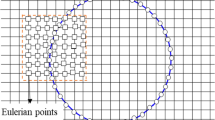Abstract
A new droplet collision and coalescence model was presented, a quick-sort method for locating collision partners was also devised and based on theoretical and experimental results, further advancement was made to the droplet collision outcome. The advantages of the two implementations of smoothed particle hydrodynamics (SPH) method were used to limit the collision of droplets to a given number of nearest droplets and define the probability of coalescence, numerical simulations were carried out for model validation. Results show that the model presented is mesh-independent and less time consuming, it can not only maintains the system momentum conservation perfectly, but not susceptible to initial droplet size distribution as well.
Similar content being viewed by others
References
Kitron A, Elperin T, Tamir A. Stochastic modeling of the effects of the liquid droplet collisions in impinging streams absorbers and combustors[J]. Int J Multiphase Flow, 1991, 17(2): 274–282.
Marion G, Dicharry C, Mendibourne B. Contribution of the modelization of the surfactant concentration influence on droplet size distribution in oil/water emulsion[J]. Progress in Collid and Polymer Science, 1993, 21(25): 307–311.
O’Rourke P J. Collective Drop Effects on Vaporizing Liquid Sprays[D]. Ph D Dissertation, Department of Mechanical and Aerospace Engineering, Princeton University, 1981.
Asheim J P, Peters J E. Modeling of a hollow-cone liquid spray including droplet collisions[J]. J Propalsion, 1988, 144(5): 231–238.
Bird G A. Molecular Gas Dynamics[M]. Clarendon Press, Oxford, 1994, 167–172.
Schmidt, David P, Rutland C J. A new droplet collision algorithm[J]. Journal of Computational Physics, 2000, 164(7): 62–80.
Monaghan J J, Gingold R A. Shock simulation by the particle method SPH[J]. Journal of Computational Physics, 1983, 52:374–389.
Btazier-Smith P R, Jennings S G, Latham J. The interaction of falling water droplets: coalescence[J]. Proc R Soc Lond, 1972, 326(2):642–648.
Jayaratne O, Mason B. The coalescence and bouncing of water drops at an air/water interface[J]. Proc R Soc Lond, 1974, 380(5):218–242.
Li Yufei. Study of RBCC[M]. Master thesis, Northwestern Polytechnical University, 2003, 42–44(in Chinese).
Author information
Authors and Affiliations
Corresponding author
Additional information
Project supported by the National Natural Science Foundation of China (No.50376054) and the Aerospace Science Foundation (No.03c53021)
Rights and permissions
About this article
Cite this article
Li, Q., Cai, Tm., He, Gq. et al. Droplet collision and coalescence model. Appl Math Mech 27, 67–73 (2006). https://doi.org/10.1007/s10483-006-0109-1
Received:
Revised:
Issue Date:
DOI: https://doi.org/10.1007/s10483-006-0109-1




